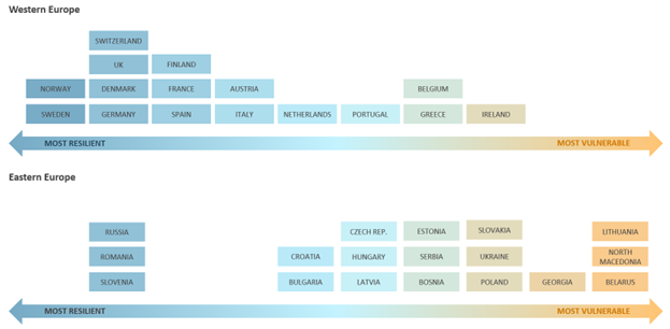As the world’s energy landscape is undergoing a significant transformation, countries around the globe are striving to secure reliable and sustainable energy supply. In this quest for energy security, several critical factors come into play, including the level of energy self-sufficiency, adoption of renewables and energy efficiency, the state of energy infrastructure, and economic resilience. By evaluating these factors, Euromonitor International’s Global Energy Vulnerability Index aims to assess individual countries’ exposure to energy shocks, marking the challenges they face and the opportunities they can seize to enhance their energy security.
High levels of energy self-sufficiency, diverse energy mix, high energy availability and efficiency, and economic affluence enhance a country’s resilience to potential energy market shocks. On the other hand, heavy dependence on external energy supply and fossil fuels, underdeveloped infrastructure, poor access to capital and weak economic resilience undermine countries’ energy security.
Self-sufficient advanced economies at the forefront of the global energy resilience
As revealed by our Global Energy Vulnerability Index, Norway, Canada, Australia and the US top the list thanks to the high levels of their energy self-sufficiency, ensuring they can meet their domestic energy demands without heavy reliance on imports.
As of 2022, the US, Canada and Norway accounted for over 28% of the global oil and natural gas output
Source: Euromonitor International
Economic stability, well-developed infrastructure and relatively diverse energy portfolios further enhance their resilience to energy market disruptions. Moreover, these countries’ proactive efforts in sustainable energy development are expected to support their leading positions.
For example, the US’s Inflation Reduction Act of 2022 will further strengthen the country’s energy security by expanding clean energy transition and modernising the US’s power grid. At the same time, Canada is set to benefit from a CAD80 billion investment plan, unveiled in spring 2023, aimed at promoting clean energy and green infrastructure.

Vulnerable developed economies accelerate efforts to boost long-term security
Advanced economies with high energy import dependency, such as Singapore, Lithuania, South Korea, Ireland and Japan, are more exposed to global energy price fluctuations and supply disruptions. Nevertheless, affluent economies possess strengths in terms of energy efficiency, economic stability, and access to advanced technologies. As the recent energy crisis has shown, most developed economies have the capability to innovate and adapt swiftly to the changing energy landscape. As a result, scaled-up investments in renewables, energy efficiency and infrastructure upgrades have helped slow down growth in energy consumption over the past several years.
In the EU, final energy consumption shrank by 0.7% between 2017 and 2022, with the largest decrease coming from the commercial and transport sectors
Source: Euromonitor International
Europe’s efforts to accelerate the green transition, including initiatives such as the European Commission’s Green Deal Industrial Plan, are expected to further mitigate its energy vulnerability.

Surging demand in Asia underscores the importance of investment in innovative energy solutions
Many emerging countries in Asia, including China, India, Vietnam, Indonesia and Malaysia, have seen a power consumption boom driven by the robust economic growth, industrialisation and urbanisation. Surging demand, coupled with insufficient access to capital and existing infrastructure constraints, poses significant challenges for many developing Asian economies in reducing their dependence on fossil fuels and building up resilience.
While China demonstrated good overall results and accounts for the lion’s share of green investment in the region, it is still grappling with significant energy efficiency and security challenges due to its energy-intensive industries, rapid urbanisation and lingering reliance on coal. There are, however, some bright spots. For example, Indonesia exhibits relatively strong resilience thanks to its diverse domestic energy supply from ample fossil fuel resources, geothermal energy and biofuels, while India has ramped up its efforts in clean energy deployment.

Despite vast renewables potential, Latin America and Africa struggle with insufficient funding
Boasting diverse energy sources, including oil, gas and hydropower, many Latin American countries enjoy high energy supply, with Brazil, Colombia and Ecuador among the top performers. However, the region’s exposure to climate change effects, such as drought and changing precipitation patterns, poses a threat to its hydropower sector. In addition, despite large untapped renewables potential, the challenging investment climate, regulatory hurdles and political instability in some Latin American countries hinder energy diversification efforts and pose barriers to investment growth.
Inadequate access to reliable and affordable energy is a key concern in sub-Saharan Africa, which hinders the region’s economic growth and social stability. While the region has attracted substantial investments in oil and gas infrastructure since last year, most of it is intended for exports rather than domestic use and electrification purposes. Moreover, despite the region’s ample renewables potential, its poor grid infrastructure, inadequate regulatory frameworks, and political and economic instability pose barriers to renewable energy investment. However, off-grid energy solutions, such as on-site solar power, with flexible financing methods can help bridge the energy gap.

Resource-rich nations reliant on energy exports face heightened risks
Owing to ample reserves of natural energy resources, nations like the Gulf economies, Russia, and Kazakhstan have a sufficient level of energy security and hold a prominent position in the global energy landscape. However, heavy reliance on exports of hydrocarbons exposes these countries to global energy price fluctuations, geopolitical risks, and the ongoing low-carbon transition. Hence, enhancing economic diversification and developing sustainable energy policies are key to improve their resilience amid the globally changing energy landscape.
While different countries face unique challenges in their pursuit of energy resilience, diversification, innovation and sustainability have emerged as key components of a common solution. However, to enhance global energy security and facilitate equitable and just energy transition, international cooperation is vital to direct more funds to developing regions. Meanwhile, developing effective regulatory frameworks, enhancing the business environment and investing in adequate energy infrastructure are key to create a more sustainable and secure global energy future.
For more insights and analysis, read Euromonitor International’s full report, New Economic Reality: Rising Energy Pressures, which is part of our report series on the key topic, New Economic Reality.





